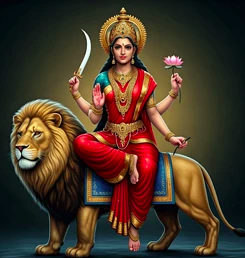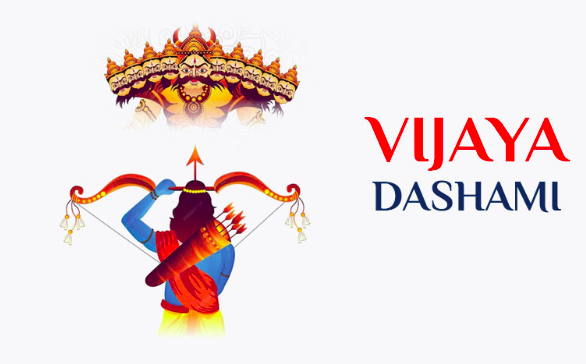
Maa Shailputri: The Goddess of Purity, Strength, and Devotion
Blog
Maa Shailputri, the first form of Goddess Durga, symbolizes purity, strength, and devotion. Born as the daughter of King Himalaya, she rides a bull and holds a trident and lotus. Worshipping her activates the Root Chakra, bringing emotional balance and stability. Her divine presence marks the beginning of Navratri, guiding devotees toward spiritual awakening. Jai Mata Di!
1050
Shivam Gangwar
6 min
Mar 30, 2025
Maa Shailputri: The Divine Goddess of the First Day of Navratri
Navratri, the nine-night festival dedicated to Goddess Durga, is one of the most auspicious and widely celebrated Hindu festivals. Each day of Navratri is devoted to one of the nine forms of Durga, known as the Navadurga. The first day of Navratri is dedicated to Maa Shailputri, the daughter of the Himalayas and the embodiment of divine strength and purity.
Who is Maa Shailputri?
Maa Shailputri, meaning "Daughter of the Mountain" (Shail = Mountain, Putri = Daughter), is the first manifestation of Goddess Durga. She was born as the daughter of King Himavan, the ruler of the Himalayas. In her previous birth, she was Devi Sati, the daughter of Prajapati Daksha and the consort of Lord Shiva. When Prajapati Daksha insulted Lord Shiva and disregarded Sati’s devotion, she immolated herself in the sacred fire. In her rebirth, she took the form of Shailputri and was reunited with Shiva.

Iconography and Symbolism
Maa Shailputri is depicted as a divine goddess seated on a Nandi (bull), holding a Trishul (trident) in her right hand and a lotus in her left hand. She has a serene and calm demeanor, representing divine power, devotion, and determination. The bull represents strength and steadfastness, while the lotus symbolizes purity and spiritual awakening.
Spiritual Significance of Worshipping Maa Shailputri
The worship of Maa Shailputri marks the beginning of the Navratri festival. She represents the Muladhara Chakra (Root Chakra), which is the foundation of spiritual energy. Devotees who seek stability, strength, and a strong foundation in their spiritual and worldly lives worship Maa Shailputri with deep devotion.
Rituals and Puja Vidhi
On the first day of Navratri, devotees wake up early and perform special rituals dedicated to Maa Shailputri:
Ghatasthapana (Kalash Sthapana) - The Navratri festival begins with the installation of a Kalash (sacred pot), which symbolizes the presence of the divine energy of the Goddess.
Offering Prayers and Mantras - Devotees offer flowers, incense, and sweets to Maa Shailputri while reciting her mantra:
“ॐ देवी शैलपुत्र्यै नमः”
(Om Devi Shailputryai Namah)
Bhog (Prasad) Offering - White-colored food items like kheer, milk, and sweets are offered as bhog, as Maa Shailputri is fond of them.
Fasting and Meditation - Many devotees observe fasts and meditate on her divine energy to receive blessings of strength and perseverance.
Legend Associated with Maa Shailputri
One of the most famous legends related to Maa Shailputri comes from her previous birth as Devi Sati. She was the daughter of King Daksha, who disapproved of her marriage to Lord Shiva. During a grand yajna (sacrificial ritual), King Daksha insulted Shiva. Unable to tolerate this insult, Sati sacrificed herself in the fire. In her next birth, she was born as Parvati, the daughter of the Himalayas (Shailputri), and later reunited with Shiva after intense penance.
Astrological Significance
Maa Shailputri is associated with the Moon (Chandra), which governs emotions, stability, and mental peace. Worshipping her helps in calming the mind, overcoming fears, and ensuring emotional balance.
Benefits of Worshipping Maa Shailputri
Brings peace and stability in life.
Enhances spiritual awakening and devotion.
Provides strength and courage to overcome challenges.
Helps in balancing emotions and achieving mental clarity.
Blesses devotees with a prosperous and harmonious life.
Conclusion
Maa Shailputri marks the beginning of the divine festival of Navratri, guiding devotees towards strength, purity, and devotion. Her worship sets the tone for the following days of spiritual awakening and inner transformation. By praying to Maa Shailputri with a sincere heart, one can receive her divine blessings for a prosperous and spiritually fulfilling life.
May Maa Shailputri bless us all with strength, purity, and wisdom on this sacred occasion of Navratri!
मां शैलपुत्री: नवरात्रि के पहले दिन की दिव्य देवी
नवरात्रि, देवी दुर्गा को समर्पित नौ रात्रियों का पर्व, हिंदू धर्म के सबसे पवित्र और व्यापक रूप से मनाए जाने वाले त्योहारों में से एक है। नवरात्रि के प्रत्येक दिन देवी दुर्गा के नौ रूपों की पूजा की जाती है, जिन्हें नवदुर्गा कहा जाता है। नवरात्रि के पहले दिन मां शैलपुत्री की पूजा की जाती है, जो हिमालय के राजा की पुत्री और दिव्य शक्ति एवं पवित्रता की प्रतीक हैं।
मां शैलपुत्री कौन हैं?
मां शैलपुत्री का अर्थ है "पर्वत की पुत्री" (शैल = पर्वत, पुत्री = बेटी)। यह देवी दुर्गा का पहला स्वरूप हैं। इनका जन्म राजा हिमावान के घर हुआ था, जो हिमालय के राजा थे। अपने पूर्व जन्म में, यह देवी सती थीं, जो प्रजापति दक्ष की पुत्री और भगवान शिव की अर्धांगिनी थीं। जब प्रजापति दक्ष ने भगवान शिव का अपमान किया और सती की भक्ति को नकारा, तब उन्होंने खुद को अग्नि में समर्पित कर दिया। अपने अगले जन्म में, वे मां शैलपुत्री के रूप में अवतरित हुईं और पुनः भगवान शिव से विवाह किया।
मां शैलपुत्री का स्वरूप और प्रतीकात्मकता
मां शैलपुत्री नंदी (बैल) पर सवार होती हैं। उनके दाहिने हाथ में त्रिशूल और बाएं हाथ में कमल होता है। उनका स्वरूप अत्यंत शांत और दिव्य होता है, जो शक्ति, भक्ति और संकल्प का प्रतीक है। नंदी बल और स्थिरता का प्रतिनिधित्व करता है, जबकि कमल पवित्रता और आध्यात्मिक जागरूकता का प्रतीक है।
मां शैलपुत्री की पूजा का आध्यात्मिक महत्व
मां शैलपुत्री की पूजा से नवरात्रि का शुभारंभ होता है। वे मूलाधार चक्र (Root Chakra) की अधिष्ठात्री देवी मानी जाती हैं, जो आध्यात्मिक ऊर्जा का आधार होता है। जो भक्त संतुलन, शक्ति और स्थिरता चाहते हैं, वे मां शैलपुत्री की आराधना करते हैं।
पूजा विधि और अनुष्ठान
नवरात्रि के पहले दिन, भक्त सुबह जल्दी उठकर मां शैलपुत्री की विशेष पूजा-अर्चना करते हैं:
घटस्थापना (कलश स्थापना) - नवरात्रि का आरंभ कलश (पवित्र जल से भरा पात्र) स्थापित करने से होता है, जो देवी की दिव्य उपस्थिति का प्रतीक है।
मंत्रों और प्रार्थनाओं का उच्चारण - भक्त मां शैलपुत्री को फूल, धूप और मिठाई अर्पित करते हैं और निम्नलिखित मंत्र का जाप करते हैं:
“ॐ देवी शैलपुत्र्यै नमः”
(Om Devi Shailputryai Namah)
भोग अर्पण - मां शैलपुत्री को सफेद रंग के भोजन जैसे खीर, दूध और मिठाई का भोग अर्पित किया जाता है।
व्रत और ध्यान - कई भक्त व्रत रखते हैं और ध्यान करके मां की कृपा प्राप्त करने का प्रयास करते हैं।
मां शैलपुत्री से जुड़ी पौराणिक कथा
मां शैलपुत्री का संबंध उनके पूर्व जन्म देवी सती से है। वे राजा दक्ष की पुत्री थीं, जिन्होंने भगवान शिव से विवाह किया था। राजा दक्ष ने अपने यज्ञ में भगवान शिव का अपमान किया, जिसे सहन न कर पाने के कारण देवी सती ने स्वयं को अग्नि में समर्पित कर दिया। अगले जन्म में, वे पार्वती के रूप में हिमालयराज की पुत्री बनीं और कठोर तपस्या करके भगवान शिव को पुनः पति रूप में प्राप्त किया।
ज्योतिषीय महत्व
मां शैलपुत्री का संबंध चंद्र ग्रह (मून) से है, जो भावनाओं, स्थिरता और मानसिक शांति का कारक है। मां शैलपुत्री की पूजा करने से मन शांत रहता है, भय दूर होते हैं और भावनात्मक संतुलन बना रहता है।
मां शैलपुत्री की आराधना के लाभ
जीवन में शांति और स्थिरता लाती हैं।
आध्यात्मिक जागरूकता और भक्ति को बढ़ाती हैं।
चुनौतियों का सामना करने की शक्ति प्रदान करती हैं।
भावनाओं को संतुलित करने और मानसिक स्पष्टता प्राप्त करने में सहायक होती हैं।
सुख-समृद्धि और सौहार्दपूर्ण जीवन का आशीर्वाद देती हैं।
निष्कर्ष
मां शैलपुत्री नवरात्रि के पावन पर्व की शुरुआत की प्रतीक हैं। उनकी पूजा से भक्तों को शक्ति, पवित्रता और भक्ति का आशीर्वाद प्राप्त होता है। नवरात्रि के इस शुभ अवसर पर मां शैलपुत्री की आराधना करके हम अपनी आत्मिक और सांसारिक यात्रा को संतुलित और समृद्ध बना सकते हैं।
मां शैलपुत्री हम सभी को शक्ति, पवित्रता और ज्ञान प्रदान करें। जय माता दी!





